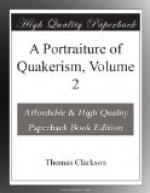The Quakers also reject the fashions of the world in the use of tomb-stones and monumental inscriptions. These are generally supposed to be erected out of respect to the memory or character of the deceased. The Quakers, however, are of opinion, that this is not the proper manner of honouring the dead. If you wish to honour a good man, who has departed this life, let all his good actions live in your memory; let them live in your grateful love and esteem; so cherish them in your heart, that they may constantly awaken you to imitation. Thus you will show, by your adoption of his amiable example, that you really respect his memory. This is also that tribute, which, if he himself could be asked in the other world how he would have his memory respected in this, he would prefer to any description of his virtues, that might be given by the ablest writer, or handed down to posterity by the ablest monument of the sculptor’s art.
But the Quakers have an objection to the use of tomb-stones and monumental inscriptions, for other reasons. For, where pillars of marble, abounding with panegyric, and decorated in a splendid manner, are erected to the ashes of dead men, there is a danger, lest, by making too much of these, a superstitious awe should be produced, and a superstitious veneration should attach to them. The early Christians, by making too much of the relics of their saints or pious men, fell into such errors.
The Quakers believe, again, that if they were to allow the custom of these outward monuments to obtain among them, they might be often led, as the world is, and by the same causes, to a deviation from the truth; for it is in human nature to praise those whom we love, but more particularly when we have lost them. Hence, we find often such extravagant encomiums upon the dead, that if it were possible for these to be made acquainted with them, they would show their disapprobation of such records. Hence we find also, that “as false as an epitaph,” has become a proverbial expression.
But even in the case where nothing more is said upon the tomb-stone than what Moses said of Seth, and of Enos, and of Cainan, and others, when he reckoned up the genealogy of Adam, namely, that “they lived and that they died,” the Quakers do not approve of such memorials. For these convey no merit of the deceased, by which his example should be followed. They convey no lesson of morality: and in general they are not particularly useful. They may serve perhaps to point out to surviving relations, the place where the body of the deceased was buried, so that they may know where to mark out the line for their own graves. But as the Quakers in general have overcome the prejudice of “sleeping with their fathers,” such memorials cannot be so useful to them.




